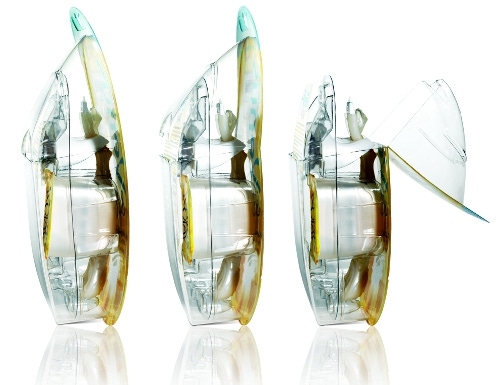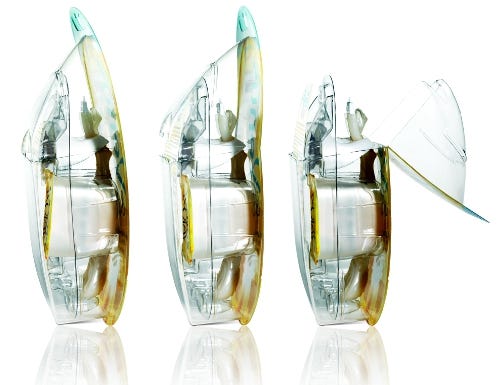

Gillette Venus
Procter & Gamble Co. doesn't do things halfway, as its groundbreaking Gillette Venus & Olay razor package—and the development story behind it—clearly demonstrate.
What's so special about this package? For starters, it's both cost effective and environmentally responsible. The package elevates the brand, and its structural design is versatile enough to accommodate all current and future Venus products. Plus it's automation-friendly and runs consistently on Gillette's global packaging lines.
The Venus & Olay blister pack, which hinges open like a clamshell, also displays well at retail, resists pilferage and breakage and opens easily—no wrap rage here. It's a package that has it all. Not surprisingly, getting it off the sketchpad and onto retail shelves took some doing.
DISRUPTION ON-SHELF
"Venus & Olay was a new product launch for us, and we wanted to come up with a new package design that created disruption on-shelf," says Mike Marcinkowski, principal engineer, R&D, Procter & Gamble Global PackDev. "This new packaging vehicle sets the bar on how we will look into the future."
The Venus & Olay razor launched globally in April 2012 in the innovative package, which consists of an outer blister pack, an inner tray, a cardstock insert and a rigid lid sealed to the blister. Previously, Gillette used a clamshell to package its women's razors.
Gillette collaborated closely with suppliers Placon and Control Group to develop the new package. Placon thermoforms the blister component from polyethylene terephthalate glycol (PETG) and the tray from recycled PET (rPET). Control Group prints and die-cuts the PETG lids and the cardstock inserts. Gillette fills the blister packs and heat seals the lids to the filled packages at P&G plants in Mexico and Eastern Europe.
The Venus & Olay package's tray securely holds the items included with the product: a razor handle and cartridge plus a storage device. For extra protection, the razor cartridge is packed in a small polypropylene cup that's sealed with easy-open flexible lidding. Gillette injection molds, fills and seals these cups in-house.
STRUCTURAL DESIGN
The project's numerous technical challenges included, for example, tight tolerances on every packaging component and the need for inks that would not be damaged by heat sealing. Then there was the matter of sealing a flat, rigid lid to the curved surface of the thermoformed blister.
But before all that could be tackled, the team needed a functional structural design for the package, one that accommodated easy packing as well as safe, easy product removal by the consumer.
The final blister design features an abundance of rounded edges, and the blister is deeper at the peg-hole end than at the base. Thermoformed undercuts-linear indentations-at both ends of the blister hold the tray in place.
The placement of the undercuts makes it possible to fill the blisters with loaded trays either manually or on automated equipment. Gillette currently is transitioning to all-automatic filling for Venus & Olay.
The blister-pack design incorporates a clever easy-open feature, as well. By placing her fingertip in the molded opening on the back of the blister, the consumer can easily tear the short lines of perforations on either side of the fingertip opening. After the perforations are broken, the package is open on three sides (the walls of the blister are pre-slit), and the consumer can bend the top of the blister back on itself and slide the tray out of the package. No scissors or other tools are needed, and the perforated/slit portions of the blister are not sharp.
The tray, made of rPET, is thermoformed with rounded edges that match the blister's shape. Cavities thermoformed into one side of the tray secure the razor handle and storage device, and a cavity on the other holds the razor cartridge.
The back of the tray is symmetrical, with two cavities, even though only one is occupied for the Venus & Olay razor. The extra cavity adds versatility for Venus products that include more than one razor cartridge.
The thermoformed rPET tray is lighter than the injection-molded PVC tray previously used for Venus packaging, which reduces the new package's weight and cost.
From a thermoforming perspective, the tray and the tooling required to make it are "quite advanced," says Dan Mohs, CEO of Placon. "There are a number of interesting features, in terms of retention mechanisms and undercuts that allow it to hold the product securely in place. There's a lot of technology in that tray."
Thermoforming and cutting recycled PET can be tricky, so Placon designed tooling suited to the material. The rPET used to make the tray is a thin-gauge, high-clarity material containing up to 100 percent post-consumer recycled content from bottles and thermoforms; the extruded sheet is supplied by Placon business unit EcoStar.
CLOSE TOLERANCES
Before Placon created the unique tooling for the blister and tray, it went through a series of design steps that included modeling and sample making. To start, the company collaborated with Gillette, using the brand owner's initial renderings to create a computer-aided design (CAD) model of the package.
"That's when the excitement really began," says Lewis Lee, Placon sales engineer. "But the pressure to engineer a multiple-plane caddy with multiple-sized cavities in an easy-open blister-package format, with an aggressive time line, was challenging."
The next step for Placon was to create a handmade, three-dimensional model of the package. After making some adjustments based on the model, the company designed and manufactured tooling using in-house tool builds so it could create thermoformed samples of the blister and tray. Placon performed heat-sealing tests and stress testing on the sealed samples to determine whether the design would be practical for manufacturing and could withstand the rigors of distribution.
Close tolerances were a central issue throughout the project, and the need for repeatable, consistent parts affected all three companies. The dimensions of the blister and tray provide just the right amount of room for filling and sealing.
In addition, the lid needed to be exactly the right size to seal properly, with no untidy, overhanging edges. The lid becomes the front panel of the package, so a neat, tight seal was essential. "That's really the only thing the consumer sees on the shelf," Marcinkowski explains.
However, the opening of the blister arcs gracefully from stem to stern, whereas the lid is flat. And the available space to seal, on the blister's flange, is only a few millimeters wide. "When you bend the lid over the blister's curved surface, you have very little space to work with—less than a millimeter total tolerance—to get the lid lined up all the way around the four sides of the blister," Lee explains.
"There are very close tolerance tools all the way around," he adds. "There's the thermoforming trim, and then in the sealing process you have to have a mated tool set, one that curves. You're trying to apply equal pressure around the whole perimeter to make the seal work."
PROTECTING THE INKS
Heat sealing additionally created a decorating challenge. "We're sealing using heat and pressure. With that comes a lot of stress, and that stress transfers into ink breakdown. We've developed methods, processes and applications that allow those plastic substrates to bond in a solid seal that doesn't affect the inks, which means we maintain the package's appeal on-shelf," Marcinkowski says.
He adds that Gillette's heat-sealing technology is patent-protected intellectual property. Many aspects of the Venus & Olay project, including the design of Gillette's custom-made packaging equipment, are similarly protected. Altogether, the company has three granted patents and five pending patent applications for this project.
The key player in formulating the package's ink chemistry was Control Group, which prints and die-cuts the 12.5-mil PETG lids. "The ink system we developed, working with Gillette and Placon, was formulated to withstand the stresses of a 400 deg F temperature, with pressure and dwell time, without the printed inks splitting or cracking," says Jeffrey Levine, partner, Control Group.
The lids are flexographically printed on a custom-made, 12-station press using UV inks, with spot screen printing plus special effects that give the lids an iridescent sheen. All printing and special effects are performed in-line, and much of the decorating technology is proprietary.
As part of the development process, Levine says, Control Group bought "a mini version of Gillette's heat-sealing machine for our lab from the manufacturer that made the full-scale machine. Placon would send us tubs, and we would make different variations to our lids and our chemistries and do all the testing in-process here. So we had a pretty good comfort level once we presented something to Gillette."
He adds, "From the first generation of the package to where we are now, there were dozens of iterations. It was a moving target, with mechanical changes, physical changes, material changes and graphic changes."
Control Group's other task, printing the cardstock inserts, was challenging in its own way. The cards are printed on the same 12-station press using both water-based and UV inks. There are text and graphics printed on both sides of the card and a bar code on one side. The two-sided printing is performed in-line, with six colors on each side.
In printing both the lid and the card, registration and the package's tight tolerances were key concerns. With the lid, "the hardest thing we had to overcome was the intricacy in the graphics—being able to print those on an extremely difficult material and keep everything in register," says Jim Imburgia, vp of operations at Control Group. "And the die-cutting has very small tolerances."
He adds, "The card is just as difficult to repeatably produce as the lid. The card is a smaller format, and it's printed on both sides. Not only do we need to keep it in register from side to side, but also from front to back." As a further complication, the card's die-cut edges are as close as 2mm from printed text.
GREEN AND COST EFFECTIVE
The Venus & Olay package has met an array of sustainability objectives while continuing to position the brand as premium. For one thing—with parts made from PETG, rPET and paperboard—the package is completely recyclable.
Plus the Venus & Olay package uses less plastic than previous Venus packaging—more than 29 percent less—and can be packed more densely for distribution. "We get more on a pallet, and we reduced the pallet weight. That gave us a significant savings," Marcinkowski says. It also decreased the package's carbon footprint, vs the clamshell.
Switching to recycled, recyclable PET for the tray addressed two of Gillette's sustainability goals: zero consumer waste to landfill and the elimination of PVC. Gillette plans to start using rPET for the lid, as well, in the near future. PET waste from thermoforming is eliminated by selling scrap back to EcoStar to be remanufactured into rPET.
PRODUCTION WINS
In addition to environmental gains, the Venus & Olay package provides Gillette with packaging-line efficiencies, reducing scrap rate and quality breaches while increasing line speed.
For example, to seal the old clamshells, Gillette relied on radio frequency (RF) welding. "The RF welding process was very slow," Marcinkowski says, adding that the new heat-sealing process represents "a win against that method in terms of everything: speed, scrap, material, cooling."
The new package design is also versatile enough for Gillette to run it in a fully automated or a semi-automated environment. This will vary, depending where in the world the product is being packaged.
Mohs, of Placon, concludes: "It's one thing to have a concept. But where the rubber meets the road is somewhere between the concept and the reality of putting this into a production environment that's repeatable, achievable from a design standpoint and meets the cost target. Those gritty little details are what's really important to a successful new product launch."
Kate Bertrand Connolly is a seasoned freelance writer based in the San Francisco area covering the packaging, food and technology markets. You can contact her at [email protected].
.
About the Author(s)
You May Also Like




